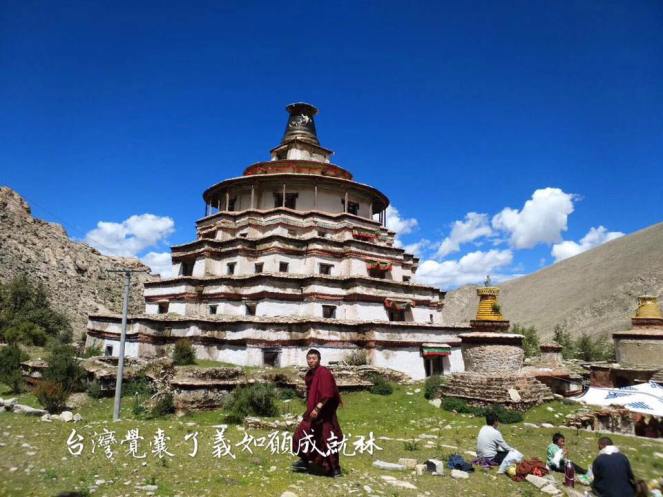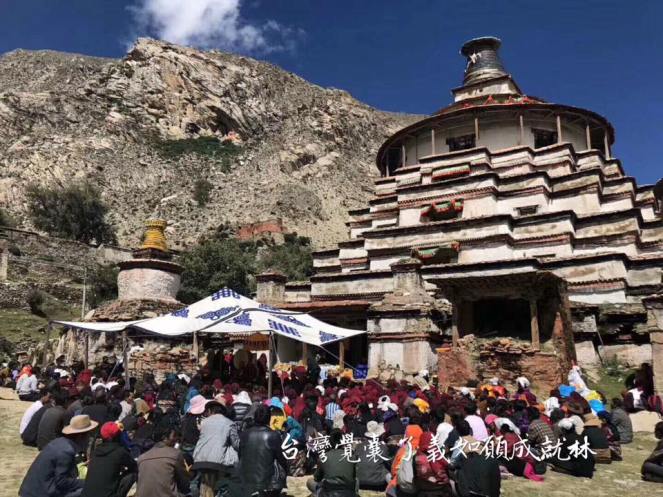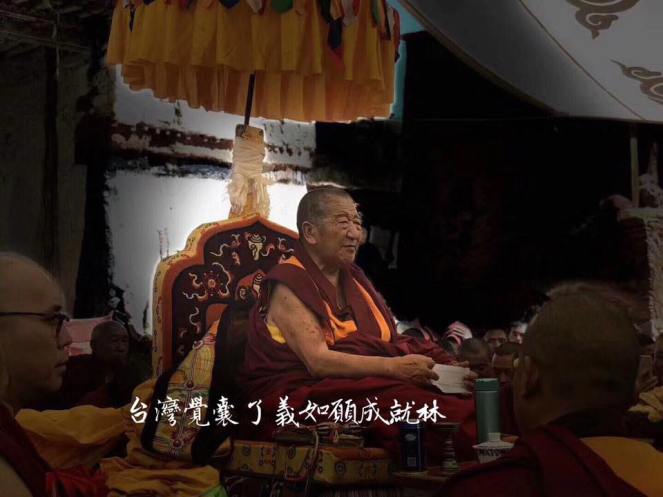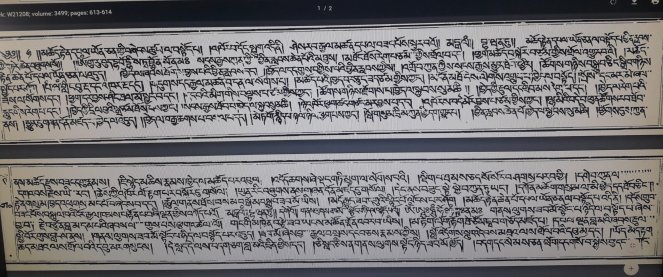Alas, although my fortune is very modest,
ཀྱེ་མ་བདག་གི་སྐལ་བ་རབ་དམན་ཡང་།
A discovery like this makes me think it is excellent fortune.
འདི་འདྲ་སྙེད་པས་སྐལ་བ་བཟང་སྙམ་བྱེད།
Is this discovery by a lazy fool due to the blessing of the Kalki emperor?
ལེ་ལོ་ཅན་གྱི་བླུན་པོས་འདི་རྙེད་པ། རིགས་ལྡན་རྒྱལ་པོས་བྱིན་གྱིས་བརླབས་ཡིན་ནམ།
Although my body did not arrive at Kalapa
ལུས་ཀྱིས་ཀ་ལཱ་པ་རུ་མ་སླེབ་ཀྱང།
did the Kalki enter my faithful mind?
དད་པའི་སེམས་ལ་རིགས་ལྡན་ཞུགས་སམ་ཅི།
Although my intelligence has not been refined in threefold insight
ཤེས་རབ་གསུམ་ལ་བློ་འགྲོས་སྦྱངས་མིན་ཡང།
I think the Ocean gushed forth due to the raising of Mount Meru.
ལྷུན་པོ་བཞེངས་པས་རྒྱ་མཚོ་རྡོལ་བ་སྙམ།
Although Noble Ones have difficulty realising the essential points
འཕགས་རྣམས་ཀྱིས་ཀྱང་རྟོགས་པར་དཀའ་བའི་གནས།
they are precisely realized, due to their kindness.
གང་གིས་དྲིན་གྱིས་ཇི་བཞིན་རྟོགས་མཛད་པ།
To all gurus, buddhas and kalkis,
བླ་མ་སངས་རྒྱས་རིགས་ལྡན་ཐམས་ཅད་དང་།
and to their great stupa, I pay homage and bow down.
དེ་ཡི་མཆོད་རྟེན་ཆེ་ལ་ཕྱག་འཚལ་འདུད།
Taken from the Biography of the Great Omniscient Jonangpa [Dolpopa] by Lhai Gyaltsen. ལྷའི་རྒྱལ་མཚན། གྷ་རུང་བ། ཆོས་རྗེ་ཇོ་ནང་པ་ཀུན་མཁྱེན་ཆེན་པོའི་རྣམ་ཐར།. Translated by Adele Tomlin, September 2018.
These words of Jonang master, Kunkhyen Dolpopa ( b.1292 – d.1361), taken from the biography of his life by one of his major students, Lhai Gyaltsen (Lha’i rgyal mtshan, Gha rung ba) , Biography of the Great Omniscient Jonangpa [Dolpopa] (chos rje jo nang pa kun mkhyen chen po’i rnam thar, as cited in The Buddha from Dolpo, STEARNS 2010: 22), refer to the construction of the massive Jonang Stupa, as ‘the raising of Mount Meru’, and the ‘Ocean that gushed’ from this construction and effort, to his most famous and profound work, Mountain Dharma: An Ocean of Definitive Meaning (Ri chos nges don rgya mtsho). It is also stated that these lines are from a series of verses that Dolpopa wrote at the end of his annotations to the Stainless Light (Vimalaprabha, Dri med ‘od) commentary (see STEARNS 2010: 322, n. 75).
Over the last few days, many photos and videos have been circulating on social media of the Jonang master, and current Head of Jonang lineage and the Dzamthang monastery in Tibet, HE Jigme Dorje Rinpoche visiting Dolpopa’s Great Jonang Stupa this month, September 2018. It is wonderful to see recent pictures of it (see below).









One video shows two monks having what are called ‘the descent of blessings’ during the Rinpoche’s visit to the stupa, whereby they appear to be spontaneously jumping and shaking up and down from their seated positions. When I asked one Jonang Rinpoche what was happening, he stated this was ‘experiential blessings’. Such occurences were apparently commonplace when Dolpopa was present and taught.
The Stupa and Its Construction
Why and when did Dolpopa build this stupa? The construction of the stupa, which was known by several different names such as Pal Yonchen, Kumbum Chenpo and Pal Gomang, is described in two biographies written by major students of Dolpopa, one by Lhai Gyaltsen (see above) and another by Kunpang Chodrag Palsang (Kun spangs chos grags dpal bzang ) the Biography of the Omniscient Lord of Dharma: The Light of the Garland of Jewels of Great Virtuous and Excellent Classifications (Chos rje kun mkhyen chen po’i rnam thar gsal sgron gyi rnam grangs dge legs chen po nor bu’i phreng ba) (see STEARNS 2010: 320: n.65).
These sources refer to a prediction by Jonang founder and master, Kunpang Tukje Tsondru (1243 – 1313), who told his disciple Yonten Gyatso:
To this hermitage of mine will come a grandson better than the son, and a great grand-son better than the grandson. In the future he will teach Dharma at upper Zangden and build a great stupa at lower Zangden. རི་ཁྲོད་འདིར་བུ་བས་ཚ་བོ་བཟང། ཚ་བོ་བས་ཀྱང་ཡང་ཚ་བཟང་བར་འོང། མ་འོངས་པ་ན་བཟང་ལྡན་གོང་མར་ཆོས་འཆད།་བཟང་ལྡན་འོག་མར་མཆོད་རྟེན་ཆེན་པོ་བཞེངས།
When Dolpopa’s master, Yonten Gyatso died, he decided to build the Great Stupa to repay his teacher’s kindness but also due to prior aspirations he had made at the stupa of Tropu Lotsawa (khro phu lo tsA ba byams pa dpal, b.1172? – d.1236?) regarding the accumulation of merit and primordial awareness that comes from building such stupas.
According to these sources, Dolpopa began construction of the stupa at Upper Sangden in 1329, but this collapsed. Then in Spring 1330, the foundations of a new stupa were commenced at Lower Sangden but people were very worried it was too big, would be impossible to finish and would end up being a ruin of earth and stone and become an object of ridicule to others. Part of Dolpopa’s reply to these concerns was (cited in STEARNS 2010: 19):
If I think about the actual condition of sentient beings in general, immeasurable compassion arises. There is no doubt that anyone who even sees, hears or touches, this stupa will be freed, that the seed of liberation will be planted, and that vast benefit for others will occur. Those who oppose it will later be regretful. སེམས་ཅན་སྤྱིའི་གནས་ལུགས་བསམ་ན་སྙིང་རྗེ་ཚད་མེད་པ་སྐྱེ། མཆོད་རྟེན་འདི་གང་གིས་མཐོང་ཐོས་རེག་པ་ཙམ་གྱིས་གྲོལ་བ་དང། ཐར་པའི་ས་བོན་ཐེབས་པ་དང། གཞན་དོན་རྒྱ་ཆེན་པོ་འབྱུང་བར་གདོན་མི་ཟ། ལོག་སྒྲུབ་ཅན་རྣམས་ཕྱིས་ན་འགྱོད་པར་གྱུར།
It is said that Dolpopa himself, along with an exceptional group of yogins, scholars and translators, such as Kunpang Chodrag Palsang, Mati Panchen Lodro Gyaltsen (1294-1376), Lotsawa Lodro Pal (1299-1354), and Chogle Namgyal (1306-1376) all participated in the construction of the stupa. It was constructed according to the descriptions in the Stainless Light commentary on the Kalacakra tantra so that is would fulfill all the necessary criteria to be considered the same as the Glorious Dhanyakataka Stupa in which the Buddha had first taught the Kalacakra Tantra.
Dolpopa wrote two texts praising this Great Stupa:
- Eulogy about How the Stupa was Built (mchod rten bzhengs tshul la bstod pa ‘khor ba dong sprug, མཆོད་རྟེན་བཞེངས་ཚུལ་ལ་བསྟོད་པ་འཁོར་བ་དོང་སྤྲུག།) and
- Eulogy to the Stupa of Jonang (mchod rten dpal yon can la bstod pa byin rlabs kyi gter chen མཆོད་རྟེན་དཔལ་ཡོན་ཅན་ལ་བསྟོད་པ་བྱིན་རླབས་ཀྱི་གཏེར་ཆེན།) (both as cited in STEARNS 2010). See picture of this Tibetan text below (from the Collected Works of Dolpopa, Dzamthang edition, TBRC, W21208):

Much of the referenced primary source material for this blog post came from The Buddha of Dolpo (Cyrus Stearns, Shambhala Publications, 2010). I am sincerely grateful for his work on this topic and more.
Written and compiled by Adele Tomlin, 9th September 2018.

